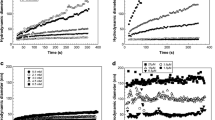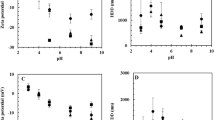Abstract
Extensive use of Al2O3 nanoparticles in consumer and industrial products has led to concerns about their potential environmental impacts in the recent years. In most studies concerning Al2O3 aggregation and disaggregation, more was to consider the single factor that influences their environmental behaviors. Understanding the combined abiotic factors that influence the fate, transport, and stability of nanoparticles in a complex aquatic system has become extremely important. Here, we reported and analyzed the major abiotic factors such as typical solution pH, electrolyte cations in different valences (Na+ and Ca2+), and the presence of humic acid (HA) that influence the stability, aggregation, and disaggregation behaviors of Al2O3 nanoparticles in a complex aquatic system. Dynamic light scattering technique combined with fluorescence spectroscopic analysis was used to explore the aggregation mechanisms. Experimental results indicated that Al2O3 nanoparticle stability was mainly controlled by the steric hindrance, van der Walls, and electrostatic interactions between HA and Al2O3 nanoparticles. Aggregation kinetics and attachment efficiency studies induced by the addition of Na+ and Ca2+ cations confirmed that divalent electrolytes could reduce the large energy barrier between the charged colloidal particles more efficiently, and induce a more aggressive aggregation of the particles. Additionally, the bridging effect of HA with Ca2+ was also an important mechanism for the aggregation enhancement, which had been confirmed by the fluorescence excitation-emission matrix (EEM) spectra analysis. These findings are useful in understanding the environmental challenges of inorganic colloidal particles in natural environments.








Similar content being viewed by others
Data availability
The datasets generated during the current study are available from the corresponding author on reasonable request.
References
Brayner R, Ferrari-IIiou R, Brivois N, Djediat S, Benedetti MF, Fiévet F (2006) Toxicological impact studies based on Escherichia coli bacteria in ultrafine ZnO nanoparticles colloidal medium. Nano Lett 6:866–870
Zhang M, Guiraud P (2013) Elimination of TiO2 nanoparticles with the assist of humic acid: influence of agglomeration in the dissolved air flotation process. J Hazard Mater 260:122–130
Lu W, Lieber CM (2007) Nanoelectronics from the bottom up. Nat Mater 6:841–850
Ma R, Levard C, Judy JD, Unrine JM, Durenkamp M, Jefferson B, Lowry G (2014) Fate of zinc oxide and silver nanoparticles in a pilot wastewater treatment plant and in proceed biosolids. Environ Sci Technol 48:104–112
Hou L, Li K, Ding Y, Li D, Chen J, Wu X, Li X (2011) Removal of silver nanoparticles in simulated wastewater treatment processes and its impact on COD and NH4 reduction. Chemosphere 12(42):248–252
Meyer DE, Curran MA, Gonzalez MA (2011) An examination of silver nanoparticles in socks using screening-level life cycle assessment. J Nanopart Res 13:147–156
Li M, Czymmek KJ, Huang CP (2011) Responses of Ceriodaphnia dubia to TiO2 and Al2O3 nanoparticles: a dynamic nano-toxicity assessment of energy budget distribution. J Hazard Mater 187:502–508
Yiamsawas T, Mahian O, Dalkilic AD, Kaewnai S, Wongwises S (2013) Experimental studies on the viscosity of TiO2 and Al2O3 nanoparticles suspended in a mixture of ethylene glycol and water for high temperature applications. Appl Energ 111:40–45
Zhu Y, Ong PP (2001) Thin films of silicon nanoparticles embedded in Al2O3 matrices. Surf Rev Lett 8(5):559–564
Laycock A, Stolpe B, Römer I, Dybowska A, Valsami-Jones E, Lead JR (2014) Rehkämper M., Synthesis and characterization of isotopically labeled silver nanoparticles for tracing studies. Environ Sci: Nano 3:271–283
Pavasupree S, Ngamsinlapasathian S, Nakajima Y, Yoshikawa S (2006) Synthesis, characterization, photocatalytic activity and dye-sensitized solar cell performance of nanorods/nanoparticles TiO2 with mesoporous structure. J Photoch Photobio A 184:163–169
Majedi SM, Lee HK (2016) Recent advances in the separation and quantification of metallic nanoparticles and ions in the environment. TRAC-Trend Anal Chem 75:183–196
Zhang XQ, Yin LH, Tang M, Pu YP (2011) ZnO, SiO2 and Al2O3 nanoparticles-induced toxic effects on human fetal lung fibroblasts. Biomed Environ Sci 24(6):661–669
Alshatwi AA, Subbarayan PV, Ramesh E, Al-Hazzani AA, Alsaif MA, Alwarthan AA (2012) Al2O3 nanoparticles induce mitochondria-mediated cell death and upregulate the expression of signaling genes in human mesenchymal stem cells. J Biochem Mol Toxic 26:469–476
Elsayed E, Mahdy A, Sherif F, Hamadeen H (2015) Evaluation of a novel water treatment residual nanoparticles as a sorbent for arsenic removal. J Nanomater 1–10
Kim IS, Baek M, Choi SJ (2010) Comparative cytotoxicity of Al2O3, CeO2, TiO2, and ZnO nanoparticles to human lung cells. J Nanosci Nanotechnol 10:3453–3458
Mafuné F, Kohno J, Takeda Y, Kondow T (2011) Dissociation and aggregation of gold nanoparticles under laser irradiation. J Phys Chem B 105:9050–9056
Aminfar H (2014) Nanoparticles aggregation in nanofluid flow through nanochannels: insights from molecular dynamic study. Int J Mod Phys C 25(11):1–23
Sorokina ON, Kovarski AL, Lagutina MA, Dubrovskii SA, Dzheparov FS (2012) Magnetic nanoparticles aggregation in magnetic gel studied by electron magnetic resonance (EMR). Appl Sci 2:342–350
Lehn RCV, Atukorale PU, Carney RP, Yang Y, Stellacci F, Irvine DJ, Alexander-Katz A (2013) Effect of particle diameter and surface composition on the spontaneous fusion of monolayer-protected gold nanoparticles with lipid bilayers. Nano Lett 13:4060–4067
Clemments AM, Botella P, Landry CC (2015) Protein adsorption from biofluids on silica nanoparticles: corona analysis as function of particle diameter and porosity. Appl Mater Interfaces 7:21682–21689
He YT, Wan J, Tokunaga T (2008) Kinetic stability of hematite nanoparticles: the effect of particle sizes. J Nanopart Res 10:321–332
Wu D, Mao F, Yang Z, Wang S, Zhou Z (2014) Silicon and aluminum co-doping of titania nanoparticles: effect on thermal stability, particle size and photocatalytic activity. Mat Sci Semicon Proc 23:72–77
Alshammari A, Köckritz A, Kalevaru VN, Martin A (2010) Influence of precursor on the particle size and stability of colloidal gold nanoparticles. Stud Surf Sci Catal 175:409–412
Guo Z, Chen G, Zeng G, Liang J, Huang B, Xiao Z, Yi F, Huang Z, He K (2016) Determination of inequable fata and toxicity of Ag nanoparticles in a Phanerochaete chrysosporium biofilm system through different sulfide sources. Environ Sci: Nano 5:1027–1035
Saito Y, Shimomura M, Yabu H (2013) Dispersion of Al2O3 nanoparticles stabilized with mussel-inspired amphiphilic copolymers in organic solvents and formation of hierarchical porous films by the breath figure technique. Chem Comm 49(54):6081
Tan L, Tan X, Fang M, Yu Z, Wang X (2018) Effects of humic acid and Mg2+ on morphology and aggregation behavior of silica aerogels. J Mol Liq 264:261–268
Pakrashi S, Dalai S, Sneha B, Chandrasekaran N, Mukherjee A (2012) A temporal study on fate of Al2O3 nanoparticles in a fresh water microcosm at environmentally relevant low concentrations. Ecotox Environ Safe 84:70–77
Son J, Vavra J, Li Y, Seymour M, Forbes V (2015) Interactions between suspension characteristics and physicochemical properties of silver and copper oxide nanoparticles: a case study for optimizing nanoparticle stock suspension using a central composite design. Chemosphere 124:135–142
Uyguner CS, Bekbolet M (2005) Evaluation of humic acid photocatalytic degradation by UV-vis and fluorescence spectroscopy. Catal Today 101:267–274
Godnjavec J, Zabret J, Znoj B, Skale S, Veronovski N, Venturini P (2014) Investigation of surface modification of rutile TiO2 nanoparticles with SiO2/Al2O3 on the properties of polyacrylic composite coating. Prog Org Coat 77:47–52
Bi Z, Li K, Jiang C, Zhang J, Ma S (2011) Effects of amphoteric oxide (Al2O3 and B2O3) on the structure and properties of SiO2-CaO melts by molecular dynamics simulation. J Non-Cryst Solids 559:120687
Fairhurst AJ, Warwick P (1998) The influence of humic acid on europium-mineral interactions. Colloid Surface A 145:229–234
Chen WP, Chi FH (2002) A study of coagulation mechanism of polyferric sulfate reacting with humic acid using fluorescence-quenching method. Water Res 36(18):4583–4591
Chen C, Wang X, Jiang H, Hu W (2007) Direct observation of macromolecular structures of humic acids by AFM and SEM. Colloid Surf A 302:121–125
Omar FM, Aziz HA, Stoll S (2014) Aggregation and disaggregation of ZnO nanoparticles: influence of pH and adsorption of Suwannee River humic acid. Sci Total Environ 468–469:195–201
Wang Y, Luo X, Han Y, Liu B, Hu Y, Liu X (2020) Preparation of monodisperse polymer particle via in situ charge neutralization-controlled particle coagulation mechanism in macroemulsion polymerization. Colloid Surface A 587:124345
Tan L, Tan X, Mei H, Ai Y, Sun L, Zhao G, Hayat T, Alsaedi A, Chen C, Wang X (2018) Coagulation behavior of humic acid in aqueous solutions containing Cs+, Sr2+ and Eu3+: DLS, EEM and MD simulations. Environ Pollut 236:835–843
Slade WH, Boss E, Russo C (2011) Effects of particle aggregation and disaggregation on their inherent optical properties. Opt Express 19(9):7945
Loosli F, Coustumer PL, Stoll S (2013) TiO2 nanoparticles aggregation and disaggregation in presence of alginate and Suwannee River humic acids. pH and concentration effects on nanoparticle stability. Water Res 47:6052–6063
Wang H, Qi J, Keller AA, Zhu M, Li F (2014) Effects of pH, ionic strength and humic acid on the removal of TiO2 nanoparticles from aqueous solution phase by coagulation. Colloid Surface A 450:161–165
Chen KL, Elimelech M (2007) Influence of humic acid on the aggregation kinetics of fullerene (C60) nanoparticles in monovalent and divalent electrolyte solutions. J Colloid Interf Sci 309:126–134
Tan L, Tan X, Fang M, Wang X, Wang J, Xing J, Ai Y, Wang X (2019) Systematic studies on the binding of metal ions in aggregates of humic acid: aggregation kinetics, spectroscopic analyses and MD simulations. Environ Pollut 246:999–1007
Engebretson RR, Wandruszka RV (1998) Kinetic aspects of cation-enhanced aggregation in aqueous humic acids. Environ Sci Technol 32(4):488–493
Tan L, Tan X, Wang X, Feng J, Fang M, Ai Y, Hayat T, Sun L, Wang X (2019) Effect of co-existing Co2+ ions on the aggregation of humic acid in aquatic environment: aggregation kinetics, dynamic properties and fluorescence spectroscopic study. Sci Total Environ 674:544–553
Yang K, Chen B, Zhu X, Xing B (2016) Aggregation, adsorption, and morphological transformation of graphene oxide in aqueous solutions containing different metal cations. Environ Sci Technol 50:11066–11075
Raza G, Amjad M, Kaur I, Wen D (2016) Stability and aggregation of titania nanomaterials under environmentally realistic conditions. Environ Sci Technol 50:8462–8472
Chen W, Habibul N, Liu XY, Sheng GP, Yu HQ (2015) FTIR and synchronous fluorescence heterospectral two-dimensional correlation analyses on the binding characteristics of copper onto dissolved organic matter. Environ Sci Technol 49:2052–2058
Conte P, Piccolo A (1999) Conformational arrangement of dissolved humic substances. Influence of solution composition on association of humic molecules. Environ Sci Technol 33:1682–1690
Kalinichev AG, Iskrenova-Tchoukova E, Ahn W, Clark MM, Krikpatrick RJ (2011) Effect of Ca2+ on supramolecular aggregation of natural organic matter in aqueous solutions: a comparison of molecular modeling approaches. Geoderma 169:27–32
Acknowledgements
The authors are thankful to the analysis and testing center of Huaiyin Institute of Technology.
Funding
This work is financially supported by the Fundamental Research Funds for the Jiangsu Provincial Key Laboratory of Palygorskite Science and Applied Technology (HPK201806) and the Fundamental Research Funds for the National & Local Joint Engineering Research Center for Mineral Salt Deep Utilization (SF201905).
Author information
Authors and Affiliations
Contributions
T.H., C.W., W.X., and S.W. conceived the study and performed the measurements. L.T., Y.W., and D.L. analyzed the results and prepared the manuscript.
Corresponding author
Ethics declarations
Conflict of interest
The authors declare no competing interests.
Additional information
Publisher's Note
Springer Nature remains neutral with regard to jurisdictional claims in published maps and institutional affiliations.
Rights and permissions
Springer Nature or its licensor (e.g. a society or other partner) holds exclusive rights to this article under a publishing agreement with the author(s) or other rightsholder(s); author self-archiving of the accepted manuscript version of this article is solely governed by the terms of such publishing agreement and applicable law.
About this article
Cite this article
Hu, T., Xu, W., Li, D. et al. Aggregation and disaggregation of Al2O3 nanoparticles: influence of solution pH, humic acid, and electrolyte cations. Colloid Polym Sci 301, 989–999 (2023). https://doi.org/10.1007/s00396-023-05124-y
Received:
Revised:
Accepted:
Published:
Issue Date:
DOI: https://doi.org/10.1007/s00396-023-05124-y




